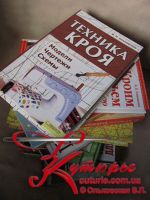So, what book should I buy so that I can read it right away - and I can do everything! ..
If you have read previous article on this topic, then you already guessed that you first need to choose the cutting technique and the presentation method that is suitable for your future activities.
Let's agree right away: in this article I will not write about my books. If you want to, see books by Vera Olkhovskaya I have on the site.
When choosing, you should also pay attention to the fact that ALL books on cutting techniques become outdated over time, therefore, you should not get hung up on old editions.
I will start my review with my favorite authors and favorite books, which I return to from time to time.
Makarenko A.F. “Panelless cutting of a woman's dress” in 1975 is perhaps the best book with a minimum of “water” and “garbage”. Simple and good presentation. The only downside is it's outdated.
Erzenkova N. V. "Women's clothing in detail" 1994, "150 models of blouses" 1994
The presentation is quite simple, logical and consistent, although the heap of indices around the letters is a little annoying. It could be recommended for beginner cutters, but, alas! Both books are very outdated. In those years, wide and broad shoulders were in fashion, so all designs are only suitable for a “woman with an oar”.
Bratchik I.M. “Lightweight women's clothing” 1993, “Designing women's outerwear of complex shapes and cuts” 1980. The presentation is heavy and it is difficult to grasp the logic due to the abundance of cumbersome designations and long formulas. Books by this author can only be recommended to those who have already mastered the cutting technique. And, of course, in many ways they are very outdated.
Now I will turn to the authors and books that made a good impression on me, were remembered and remained in my library.
V. E. Bochkareva “Sew without fittings” 1994. I have not seen anywhere a more detailed classification of figures than Bochkareva’s. But, unfortunately, it is not clear who this book is aimed at. If for advanced tailoring cutters, then the selective description of sewing operations in this book is out of place. The presentation is chaotic.
 Zlachevskaya G. M. "We sew without trying on a non-standard figure." I liked the book very much. It is clearly addressed to those who want to seriously engage in individual tailoring. But I wouldn't recommend it for learning. The fact is that the most difficult moment in the Zlachevskaya method is measurements. There are a lot of them and you need to shoot them very accurately. That is, the very process of taking measurements according to Zlachevskaya can only be mastered by professional cutters or students who study directly from her courses.
Zlachevskaya G. M. "We sew without trying on a non-standard figure." I liked the book very much. It is clearly addressed to those who want to seriously engage in individual tailoring. But I wouldn't recommend it for learning. The fact is that the most difficult moment in the Zlachevskaya method is measurements. There are a lot of them and you need to shoot them very accurately. That is, the very process of taking measurements according to Zlachevskaya can only be mastered by professional cutters or students who study directly from her courses.
Another reason to deprive this methodology of recommendations is that the vast majority of customers are people with rather “simple” figures, for which 20-odd measurements are enough to measure. That is, those measures used by many couturiers for several generations now.
Well, a group of books on the method of designing clothes for mass tailoring at large sewing enterprises. It is called TSNIISHP - the methodology of the Central Research Institute of the Garment Industry. It is proposed to use "standard" dimensional features, increments and take into account the technological properties of fabrics (shrinkage, wear) already at the design stage.
Even “under Tsar Pea”, the population was measured by this institute, and, as far as I know, no one over the next 60 years studied the dimensional characteristics and typology of figures in such detail.
And in the meantime, the people grew noticeably larger, the fabrics changed and led to a change in sewing technology ... In general, the methodology and tables that formed the basis of the TsNIIShP methodology were hopelessly outdated.
I already wrote a little more about those same sizes in an article about how to choose the size of the pattern.
Therefore, I recommend books devoted to this technique only for familiarization with specialists in mass sewing.
I have not come across any books on the CMEA methodology (CMKO CMEA - a unified method for designing clothes of the CMEA member countries). But it was this technique that made it possible to automate the development of structural drawings and formed the basis of many modern computer-aided design systems.
Yes, I did not say anything about Muller, Lin Jacques and the COTSHL technique ...
All of them “stand in the same positions” - they combine information about typical calculation options and measurements taken from a particular person. People praise them...


 Join my community on Viber...
Join my community on Viber...











